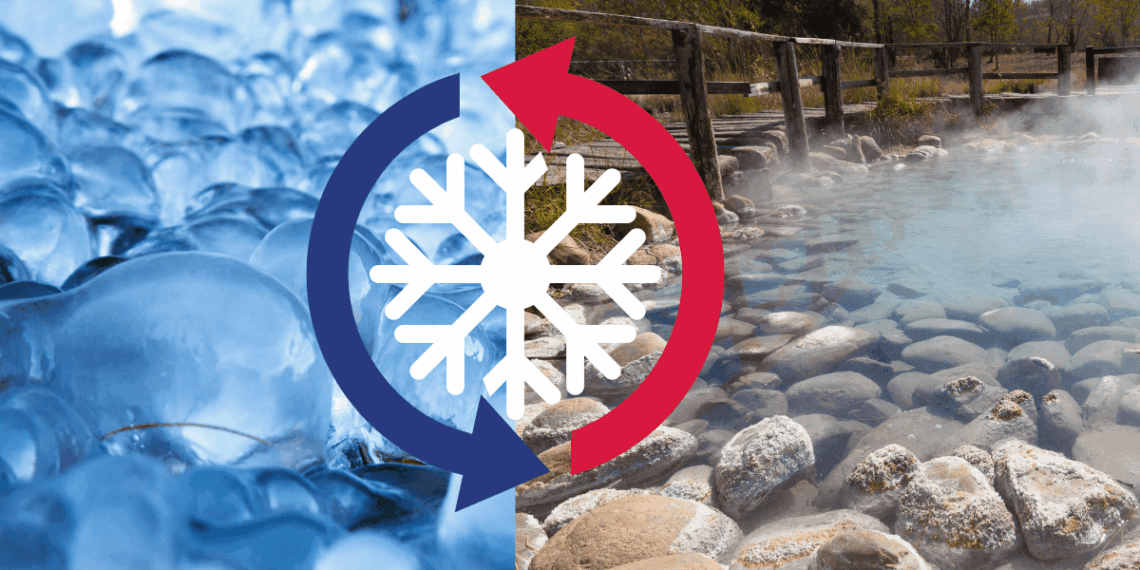Cold Plunge vs. Hot Bath: A Comprehensive Guide to Their Benefits and Uses
In the wellness and recovery world, cold plunges and hot baths are two of the most talked-about practices. Both methods offer distinct benefits for the body and mind, but how they work, and when to use them, differs. Let’s dive into the specifics of each, their science-backed benefits, and how to use them effectively.
Cold Plunge: A Powerful Tool for Recovery and Alertness
A cold plunge involves submerging the body in cold water, typically between 50°F to 59°F (10°C to 15°C), for a short duration—usually 3 to 10 minutes. Cold immersion is often used for reducing muscle soreness, improving circulation, and enhancing recovery after physical exertion.
Key Benefits of a Cold Plunge:
- Reduces Muscle Inflammation and Swelling:
Cold exposure constricts blood vessels, which helps to reduce inflammation and swelling in muscles and joints. This makes cold plunges a staple recovery tool for athletes, especially after intense exercise or injury. After exiting the cold water, the body experiences a rebound effect—blood vessels dilate, which helps flush out metabolic waste products and delivers oxygen-rich blood to the tissues, aiding in muscle recovery. - Enhances Circulation:
The body’s response to cold water is to direct blood flow to vital organs, preserving warmth. Once you exit the cold plunge, blood rushes back to the extremities, improving overall circulation. This can aid in cardiovascular health and speed up muscle repair after strenuous activity. - Boosts Mood and Mental Clarity:
Immersing in cold water triggers the release of norepinephrine, a neurotransmitter that can enhance mood, reduce pain sensitivity, and increase focus. The shock of cold water also stimulates the sympathetic nervous system (the fight-or-flight response), which leads to higher levels of alertness and energy post-plunge. - Decreases Stress and Anxiety:
Cold water immersion has been shown to increase endorphin levels (the body’s natural “feel-good” hormones) and lower cortisol, the primary stress hormone. This can lead to an improvement in mood and a reduction in overall anxiety levels.
Who Should Try It?
- Athletes and Fitness Enthusiasts: Cold plunges are particularly useful for reducing post-exercise soreness and speeding up muscle recovery.
- People with Inflammatory Conditions: Cold water helps alleviate swelling and discomfort caused by conditions like arthritis or tendinitis.
- Individuals Seeking a Mental Boost: Cold immersion is great for those looking to sharpen focus, increase alertness, and combat fatigue.
Safety and Considerations:
- Duration: Limit exposure to 3-10 minutes. Prolonged exposure to very cold water can lead to hypothermia or shock.
- Health Precautions: Those with heart conditions, high blood pressure, or poor circulation should consult with a doctor before attempting cold plunges, as the shock to the system can be intense.
Hot Bath: The Ultimate Relaxation and Stress-Relief Ritual
A hot bath involves soaking in water heated to 100°F to 104°F (37°C to 40°C). It’s a therapeutic practice that has been used for centuries to ease muscle tension, promote relaxation, and improve sleep. Hot baths stimulate heat receptors in the skin, which activate the parasympathetic nervous system—the body’s rest-and-digest response.
Key Benefits of a Hot Bath:
- Muscle Relaxation and Pain Relief:
Heat dilates blood vessels, which increases blood flow to muscles and joints, helping to relax tight muscles and ease tension. This makes hot baths excellent for anyone experiencing muscle stiffness, chronic pain, or discomfort from stress and daily activities. - Promotes Better Sleep:
A warm bath before bed raises your body temperature, and as you cool down afterward, your body signals that it’s time to sleep. This helps promote deeper and more restful sleep, making hot baths a perfect pre-sleep ritual for those struggling with insomnia. - Improves Circulation and Detoxification:
The heat of the water encourages sweating, which is a natural way for the body to flush out toxins. Improved circulation also supports cardiovascular health and can enhance skin appearance by increasing blood flow to the skin’s surface. - Mental and Emotional Well-being:
Soaking in a hot bath has a calming effect on the body, which helps reduce stress and anxiety. The warmth relaxes muscles and the mind, creating a tranquil environment that encourages mindfulness and a sense of emotional balance.
Who Should Try It?
- People with Chronic Muscle Tension or Pain: If you’re dealing with stiffness, back pain, or tension headaches, a hot bath can provide soothing relief.
- Individuals Seeking Stress Relief: Hot baths are ideal for anyone needing a break from daily stress or looking to decompress.
- Those with Sleep Issues: A pre-bedtime soak can improve sleep quality by inducing relaxation and preparing the body for rest.
Safety and Considerations:
- Hydration: Hot baths can cause dehydration due to sweating, so it’s important to drink plenty of water before and after soaking.
- Avoid Prolonged Soaks: Limit bath time to 20-30 minutes to avoid overheating and dizziness.
- Certain Health Conditions: If you suffer from low blood pressure, skin conditions, or cardiovascular issues, consult with a healthcare provider before using hot water baths regularly.
Cold Plunge vs. Hot Bath: Which One Should You Choose?
When to Choose a Cold Plunge:
- Post-Exercise: After intense physical activity, a cold plunge can help reduce muscle inflammation and accelerate recovery.
- For Mental Clarity: When you need a burst of energy or focus, the cold plunge’s ability to increase norepinephrine and endorphins makes it an excellent mental refresher.
- Reducing Swelling: Cold immersion is effective for managing swelling or injury in joints and muscles.
When to Choose a Hot Bath:
- To Relax: If you’re looking to unwind after a stressful day, a hot bath will soothe muscles, reduce tension, and calm the nervous system.
- For Better Sleep: A hot bath taken about an hour before bed can significantly improve sleep quality by helping your body cool down and induce a state of relaxation.
- Chronic Pain Relief: For people with chronic pain, arthritis, or stiffness, the heat from a bath can relieve discomfort and ease tension.
Alternating Between Cold Plunge and Hot Bath: A Powerful Duo
For maximum benefits, you can alternate between the cold plunge and hot bath. This method, often called contrast therapy, combines the benefits of both heat and cold to stimulate blood circulation, reduce muscle soreness, and improve recovery. For example, you might spend 3-5 minutes in a cold plunge, followed by 10-15 minutes in a hot bath, then repeat the process. This can increase the effectiveness of both treatments and help rejuvenate the body more efficiently.
Conclusion: Tailor Your Routine to Your Needs
Cold plunges and hot baths each offer unique benefits that can be tailored to specific needs. Cold plunges are ideal for muscle recovery, reducing inflammation, and boosting mental clarity, while hot baths excel at promoting relaxation, improving circulation, and relieving chronic pain. Both can enhance your wellness routine, depending on your immediate goals, whether it’s recovery, relaxation, or stress reduction.
By understanding the specific benefits of each practice, you can decide which one to incorporate into your routine, or even alternate between them for optimal results. Remember, always listen to your body and take safety precautions to ensure the best possible experience.
#journosnews
#HealthyTips
This article was rewritten by JournosNews.com based on verified reporting from trusted sources. The content has been independently reviewed, fact-checked, and edited for accuracy, neutrality, tone, and global readability in accordance with Google News and AdSense standards.
All opinions, quotes, or statements from contributors, experts, or sourced organizations do not necessarily reflect the views of JournosNews.com. JournosNews.com maintains full editorial independence from any external funders, sponsors, or organizations.
Stay informed with JournosNews.com — your trusted source for verified global reporting and in-depth analysis. Follow us on Google News, BlueSky, and X for real-time updates.













